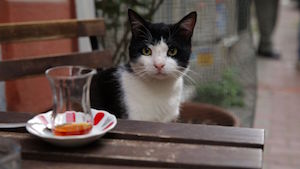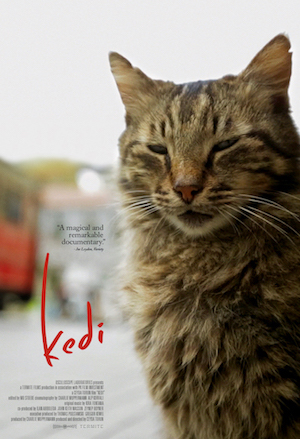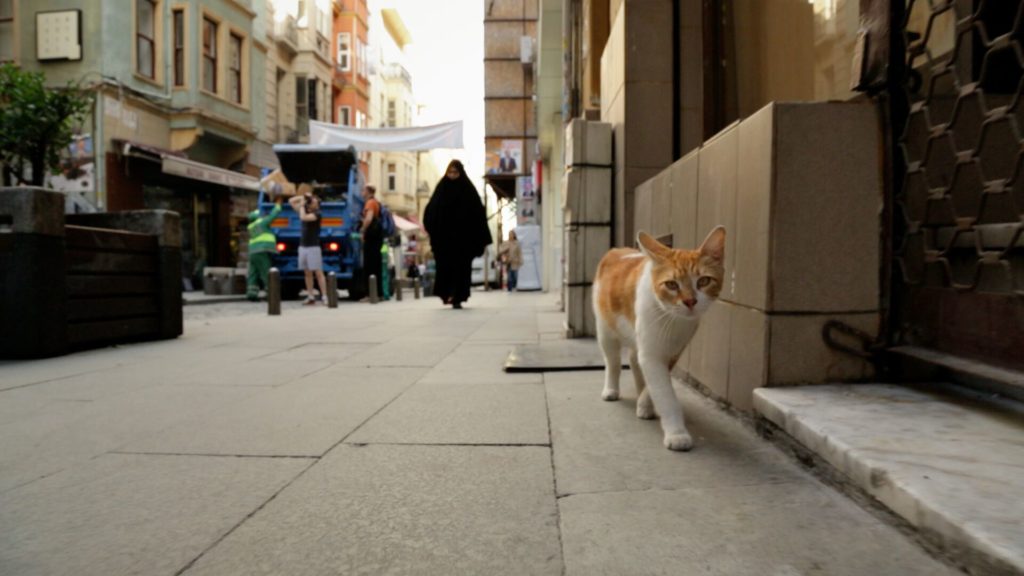Kedi: Top Film on Istanbul’s Cat Dining
 (Gerry Furth-Sides) Animals and dining at a restaurant. KEDI makes you wonder why cats everywhere don’t hop up to join guest at an outdoor table of a restaurant or make friends in the street as you pass them in the street. It is such a natural feeling, and so much in contrast to the main talk about the feline population in the US which centers on over-population and little else.
(Gerry Furth-Sides) Animals and dining at a restaurant. KEDI makes you wonder why cats everywhere don’t hop up to join guest at an outdoor table of a restaurant or make friends in the street as you pass them in the street. It is such a natural feeling, and so much in contrast to the main talk about the feline population in the US which centers on over-population and little else.
My first introduction to easy restaurant dining was during a trip to Paris years ago. An elegant young couple near me at a beautiful white tablecloth restaurant took leave of their table after they finished a late supper. They smiled at me, pulled out motorcycle helmets from under the table, and before I could blink, also pulled up a little basket with a dog instead of it.
By the way, that’s Gamziz above, either taking in the cafe scene or waiting to be fed. Kedi also shows one of his human friends feeding him at home.

KEDi is at once a film spiritual and indivudal about the hundreds of years, prowling the streets and making themselves irresistible to so many people, many of whom befriend, care and even pamper them. The trailer says it all: //www.kedifilm.com. It is a film that, like a cat, arrives as a whisper and makes its presence known as a lion.
The connection to ethnic food in this engaging cat meditation of sorts, is what Istanbul residents feed the thousands of stray cats and what the cats manage to come up with themselves, whether mice or bagging food from outdoor markets. In a port city this includes plenty of fish from friends, and friends who insist on home cooking (chicken foremost) for their transient charges. One cat literally knocks on the glass window pane of a shop to announce he is there for a meal of cheese and meats. One kind man feeds entire groups across the city with bags of fish.
 KEDI (kitty) Ceyda Torun’s debut documentary film about the cats of Istanbul opens on a series of sequences that take your breath away even on a small computer screen.
KEDI (kitty) Ceyda Torun’s debut documentary film about the cats of Istanbul opens on a series of sequences that take your breath away even on a small computer screen.
 “There’s a mystery, an unpredictability about both cats and Istanbul,” says Torun, “each of which is deeply intertwined for thousands of years.
“There’s a mystery, an unpredictability about both cats and Istanbul,” says Torun, “each of which is deeply intertwined for thousands of years.
She mentions that a zoologist at Istanbul University showed Torun a 3,500-year-old cat skeleton uncovered during construction of the Marmaray’s underwater rail system. “It was dug up right on the coast of the Bosphorus Strait and has a healed bone on its leg,” Torun says, “ in the way that it did if it was wrapped up by a human.”
Istanbul’s long history as a port city connects directly to its street-cat capital status. Felines from all over the world found their way to the city on the cargo boats where they were kept to take care of mice, were left on their own during port calls and stayed.
When the Ottomans built Istanbul’s first sewer systems, cats proved useful at fending off rodents on land, so much so that houses were constructed with cat doors, says Torun, a task of caring that has grown and now appears almost daunting in the explosive building boom.
“The more every bit of green space and soil in the city is flattened and paved over, the more inhospitable it becomes to cats,” Torun says. “And you’ve really started seeing a lot more people putting out food and water for street animals over the last five to ten years as summers have become hotter. There’s a bigger push to see that they’re OK.”
KEDI is exactly the right length (79 minutes) , engaging and making you come away wondering what will happen to the cats we met.
Critics have said that “there is no great insight here,” no connection to the future of these cats. However, like a book made into a splendid film, its engaging qualities prod the viewer into more research. And in fact, a national conference has just taken place to determine how to care for the cats.


 Gerry Furth-Sides
Gerry Furth-Sides  Barbara Hansen
Barbara Hansen  Chef-owner Alain Cohen
Chef-owner Alain Cohen  Roberta Deen
Roberta Deen  Jose Martinez
Jose Martinez  Nivedita Basu
Nivedita Basu